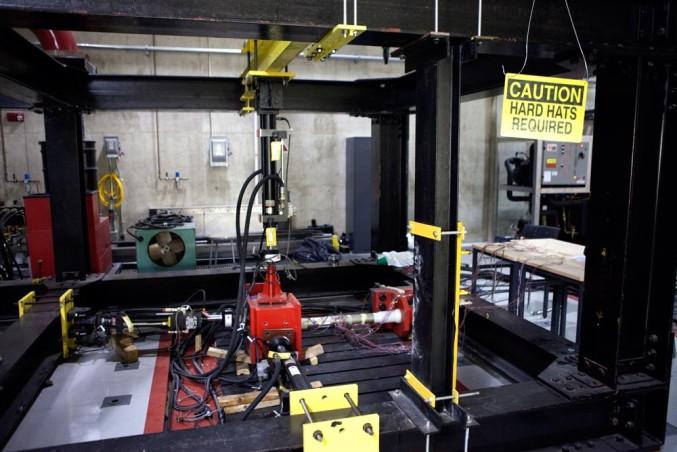Ryerson researchers are bending, twisting, breaking and burning some of the most expensive airplane components money can buy. Jeff Lagerquist investigates how eco-friendly flights might soon become reality
Below the George Vari Engineering and Computing Centre lies a high-tech research facility that most Ryerson students don’t even know exists.
Past an unmarked door and down a flight of slate-grey stairs is the ominous groan of powerful machinery. This is The Facility for Research on Aerospace Materials and Engineering Structures — or FRAMES for short — and it looks like the high-tech lair of a super villain, torn from the pages of a vintage comic book.
But appearances aside, FRAMES is a major asset to the university. The facility has drawn serious interest from the aviation industry and is putting Ryerson on the cutting edge of aerospace technology and development.
“I take pride in the fact that I was among the first in my area of research,” said Zouheir Fawaz, a professor in Ryerson’s department of aerospace engineering. “This facility is pretty much number one in Canada and the university system.”
After coming to Ryerson in 1997, Fawaz used grant funding to acquire most of the equipment in the FRAMES facility. With a team of about a dozen research assistants, he is now working on two major projects, both aimed at reducing the environmental impact of the next generation of commercial aircraft.
One, an algae-based biofuel, is being tested in collaboration with researchers from McGill and Laval universities for $5 million, as well as the National Research Council, Pratt & Whitney Canada and India based Infotech Enterprises Ltd.
Separate research into lightweight composite materials capable of withstanding extreme temperatures is also underway.
“If biofuels can replace fossil fuels, greenhouse gas emissions will be reduced,” Fawaz explained.
“And by using a lighter composite material in the construction of aircraft we can improve fuel efficiency and further minimize the impact on the environment.”
In fact, up to 9 per cent of total climate change created by humans is the result of air travel, according to the David Suzuki Foundation. In the future, that figure is likely to increase — which makes the research done at the FRAMES facility all the more important.
But before we can enjoy lightweight, algae-powered planes, a great deal of testing must first be done.
Researchers at the facility use a state-of-the-art clean room to soak a variety of aircraft components in the experimental fuel for as long as 28 days, simulating the long-term effects on an aircraft’s inner workings. The sample materials are then subjected to a variety of tests — some more violent then others.
“We’re breaking this to failure,” said John Montesano, a PHD student in the aerospace engineering program, as a piece of composite material pops and splinters nearby. One of many machines designed to crush, crack and burn is pulling apart the composite material with over 1,000 lbs. of force.
“It breaks in stages but can still take load. That’s what you want in airplane material,” added Fawaz.
Although such materials are both lightweight and strong, the high temperatures created by an aircraft engine’s pre-combustion chamber could cause them to melt or burn. That’s why the facility’s researchers are performing numerous heat-related tests, with hopes that the composite formula can withstand temperatures up to 260°C without issue. If successful, project sponsor Pratt and & Whitney Canada will use the new material to reduce the weight of their aircraft engines and increase fuel efficiency in the process.
With the life of a modern aircraft lasting over three decades, the decisions engineers make today will be felt for years to come.
“We are providing the aircraft engineering community with more choices,” said Fawaz. And if the technology manages to survive Ryerson’s underground torture chamber intact, greener aviation might be one step closer to taking off.
Photo: Chris Dale










Leave a Reply